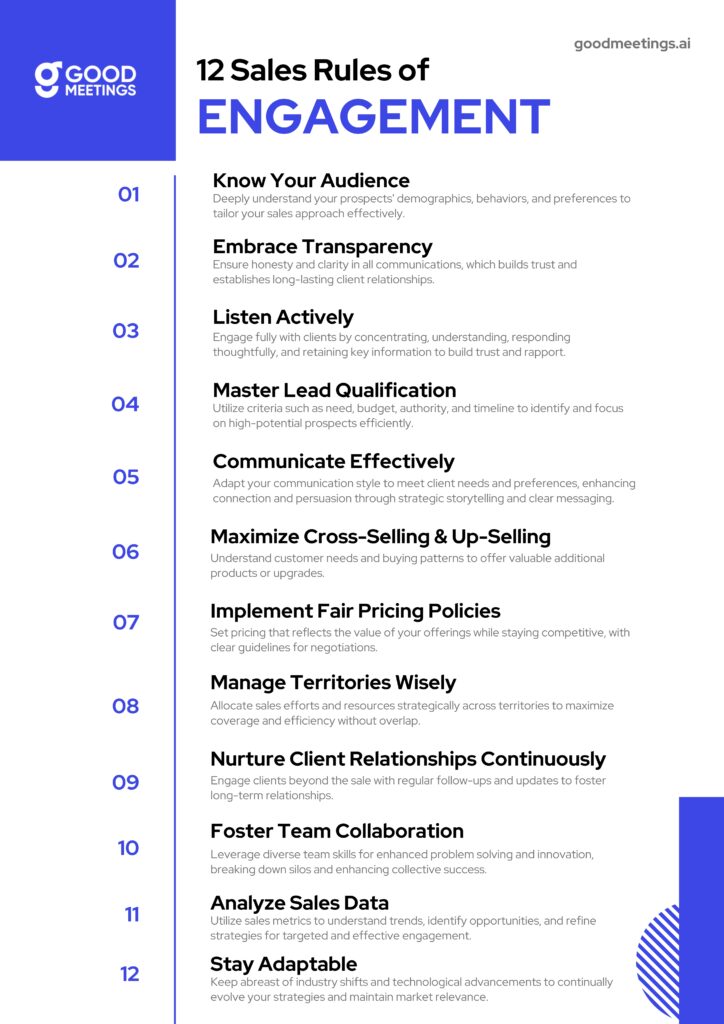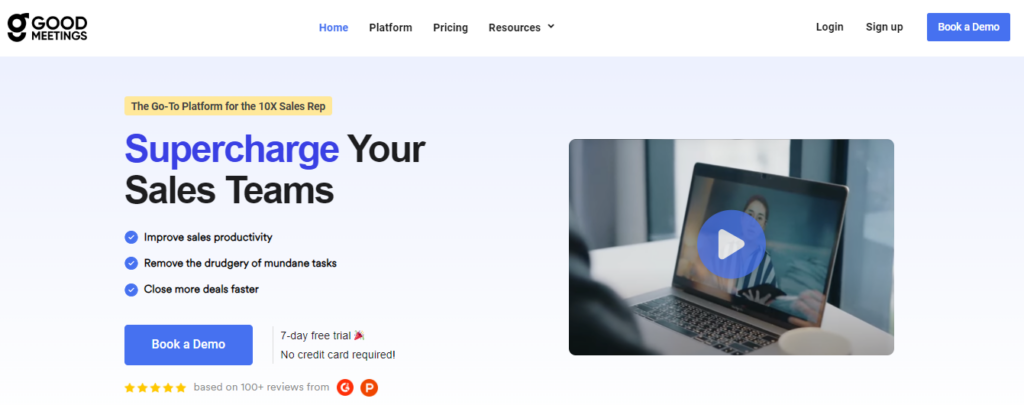Navigating the intricacies of sales requires more than just a persuasive pitch. It demands a deep understanding of human behavior, effective communication techniques, and strategic planning.
From building rapport to closing deals, every interaction with a potential customer is an opportunity to demonstrate value and establish trust.
In this comprehensive guide, we’ll delve into key sales rules of engagement.
Here, you’ll discover the core principles that guide successful sales practices, learn how to apply these strategies within your unique sales environment, and identify common challenges to avoid.
Whether you’re engaging with clients face-to-face, over the phone, or through digital channels, these rules will help you build meaningful, productive relationships that drive sustained growth.
What are Sales Rules of Engagement?
Sales rules of engagement refer to a set of guidelines or principles that govern interactions between salespeople and their prospects or clients.
These rules outline how sales professionals approach potential deals and set clear expectations for communication, negotiation, and follow-up processes.
By adhering to these rules, sales teams can navigate client interactions with consistency, professionalism, and integrity, leading to more effective sales cycles and improved outcomes.
At its core, sales rules of engagement are designed to:
- Enhance communication: They ensure that all interactions with clients are meaningful, respectful, and tailored to meet their needs. This involves listening actively, responding promptly, and communicating clearly and concisely.
- Streamline sales processes: By providing a clear roadmap for engagement, these rules help eliminate guesswork and variability in the sales process to make it more efficient and predictable.
- Build trust and credibility: Consistency in engagement helps build trust with clients. When clients know what to expect in their interactions with your sales team, it enhances your team’s credibility and reliability.
- Facilitate collaboration: In teams where multiple members may interact with the same client, having a set of engagement rules ensures everyone is on the same page. This in turn prevents conflicts and ensures a unified approach.
- Improve client satisfaction: Ultimately, a structured approach to engagement leads to a better understanding of client needs, more personalized service, and higher satisfaction rates, which can translate into long-term loyalty and more successful sales.
These rules ensure that every step of the sales process is aligned with the company’s values, the sales team’s goals, and the clients’ expectations.
This alignment is crucial not only for closing individual sales but also for fostering sustainable relationships that can drive future business.
12 Must Follow Sales Rules of Engagement

Image Source: Goodmeetings
Now that we’ve covered the concept of sales rules of engagement, let’s dive into the specific principles that every sales professional should incorporate into their approach.
These 12 rules will serve as guiding principles to enhance your effectiveness, build trust with customers, and drive successful outcomes in your sales engagements.
1. Understand your target audience
This involves a deep dive into the demographics, psychographics, and behavior patterns of your prospects.
It will help you tailor your sales approach, messaging, and solutions to meet the specific needs and preferences of your audience.
You can employ market research, customer feedback, and sales analytics to build a comprehensive profile of your target audience.
Overall, with this first rule of engagement, you can personalize your sales pitches and make them more relevant and compelling to each prospect.
2. Embrace transparency and honesty
Transparency and honesty in all interactions not only build trust but also establish long-term relationships with clients.
This involves clear communication about product capabilities, pricing, and the value proposition, ensuring that customers make informed decisions.
Upholding integrity in sales practices fosters credibility and loyalty, key components of sustainable sales success.
3. Listen actively
Active listening is a critical skill that goes beyond merely hearing the words a prospect or client says.
It involves fully concentrating, understanding, responding, and then remembering what is being said. This skill is fundamental for building trust and rapport with clients, as it demonstrates respect for their perspectives and a genuine interest in their needs and challenges.
Active listening enables you to uncover deeper insights about a client’s business, pain points, and the underlying motivations behind their purchasing decisions.
Implementing active listening involves several key practices:
- Maintaining eye contact;
- Using verbal and non-verbal cues to show engagement;
- Paraphrasing or summarizing what the client has said to ensure understanding;
- Asking open-ended questions that encourage further explanation, etc.
4. Clearly understand lead qualification criteria
A firm understanding of lead qualification criteria is crucial for identifying which prospects are most likely to convert into paying customers.
Lead qualification criteria are the benchmarks used to evaluate whether a potential lead is a good fit for the company’s products or services, taking into account factors such as their specific needs, budget, decision-making authority, and the timeline for purchase.
This understanding allows you to efficiently allocate your time and resources to nurturing high-potential leads.
Related: The BANT Method for Lead Qualification
5. Communicate effectively
How well you communicate with prospects significantly influences how you connect with, persuade, and ultimately win over potential clients.
It’s important to tailor your communication styles to suit different audiences, choosing the right words, tone, and medium to convey messages in a way that resonates with the client’s preferences and needs.
In essence, effective communication in sales goes beyond just speaking and presenting; it involves active listening, empathy, clarity, and the ability to articulate the value proposition in a compelling and understandable manner.
Techniques such as storytelling and the strategic use of customer success stories can transform abstract benefits into tangible scenarios, making it easier for clients to see the real-world impact of a solution.
Related: 10 Critical Sales Communication Skills For Success in 2024
6. Employ effective procedures for cross-selling & up-selling
This next sales rule of engagement is crucial for maximizing the value of existing customer relationships.
Cross-selling involves offering related or complementary products or services to an existing customer, while up-selling entails persuading customers to purchase a more expensive or upgraded version of what they’re buying.
Both strategies depend on a deep understanding of customer needs, preferences, and buying patterns, enabling sales professionals to identify and present additional offerings that genuinely add value to the customer.
7. Set proper pricing & discount policies
Doing this helps you maintain a healthy profit margin while remaining competitive in the market.
These policies should reflect the value your products or services provide, market demand, competitor pricing, and overall business objectives.
Sales teams should be well-informed about the pricing structure and empowered to negotiate within predefined boundaries, as it ensures consistency and fairness in pricing across all customer interactions.
8. Adequately manage territories
Territory management is a strategic approach to allocating sales resources and efforts across different geographic areas, market segments, or customer types to maximize efficiency, coverage, and sales outcomes.
Effective territory management enables sales professionals to prioritize their efforts, allocate resources efficiently, and focus on high-potential prospects within their assigned territories.
By defining clear boundaries and objectives for each territory, sales teams can minimize overlap and conflicts while ensuring equitable distribution of opportunities.
9. Continuously nurture client relationships
This process involves engaging with clients beyond the initial sale, offering support, and providing value-added services that enhance their experience with your product or service.
By maintaining regular contact through follow-ups, check-ins, and updates on new offerings or industry insights, your team can demonstrate their ongoing commitment to meeting the client’s needs.
Overall, this sales engagement rule underscores the importance of viewing sales as a long-term relationship rather than a one-time transaction.
10. Collaborate and share knowledge within the team
This is essential for maximizing collective performance and achieving shared goals.
Collaboration involves leveraging the diverse skills, experiences, and perspectives of team members to tackle challenges, generate innovative ideas, and deliver comprehensive solutions to customers.
By fostering a culture of collaboration, sales teams can break down silos, promote cross-functional teamwork, and harness collective intelligence to drive success.
11. Measure and analyze sales data
Analyzing sales data will help you understand performance trends, identify growth opportunities, and make informed strategic decisions.
Through a detailed analysis of sales figures, conversion rates, customer feedback, and other key metrics, sales teams can gain insights into what strategies are working, which areas need improvement, and how to better align their efforts with customer needs and market demands.
This data-driven approach enables teams like yours to refine their targeting strategies, optimize their sales processes, and improve the effectiveness of their pitches and presentations.
12. Adapt and evolve with the market
As you may already know, the sales world is always evolving. So, adaptability is key to staying relevant.
Staying informed about industry trends, customer preferences, and technological advancements can help you evolve your strategies and offerings.
Related: What is Sales Acceleration? – Tools and Tactics Included
Common Sales Rules of Engagement Mistakes to Avoid
While understanding and implementing effective sales rules of engagement is crucial, it’s equally important to recognize and steer clear of common pitfalls that can hinder your success
By doing this, you can navigate your engagements more effectively and foster stronger, more productive relationships with clients.
Here are some mistakes to watch out for:
1. Ignoring the value of personalized communication
Treating every client interaction with a one-size-fits-all approach is a common error that undermines the potential for genuine connection.
Personalized communication, tailored to the client’s industry, business size, or even personal interests, can significantly enhance engagement and show that you value the client as an individual, not just a sales target.
2. Setting unrealistic expectations
A common misstep is the temptation to over-promise to secure a sale. While this may win a short-term victory, it sets an unrealistic expectation that can harm client relationships in the long run.
Not delivering these promises erodes trust and credibility, which may potentially damage the reputation of both the sales representative and the company.
It’s essential to be honest and transparent about the capabilities and limitations of your product or service by setting practical expectations from the start.
3. Neglecting customer feedback
Ignoring or not actively seeking customer feedback is a critical mistake that can stifle improvement and innovation.
Feedback is a valuable source of insight into what is working well and what could be improved. It can highlight areas for product development, reveal gaps in the market, and help tailor sales strategies to better meet customer needs.
Engaging with customers for feedback demonstrates that you value their opinions and are committed to offering solutions that genuinely meet their needs.
4. Not leveraging social proof
Social proof, such as customer testimonials, case studies, and reviews, is a powerful tool for establishing credibility and trust.
Not incorporating social proof into your sales process is a missed opportunity to demonstrate the value and effectiveness of your product or service through the experiences of others.
Sharing success stories and endorsements can help potential customers visualize the benefits of choosing your solution, significantly influencing their decision-making process.
5. Failing to follow up
Follow-up is a critical component of the sales process, yet it’s often overlooked or inadequately managed.
Whether it’s after an initial meeting, a proposal submission, or a sale, timely and thoughtful follow-up is essential for moving the process forward, addressing any concerns, and ultimately, closing deals.
Neglecting to follow up can lead to lost sales and give the impression of disinterest or unreliability.
So, if you want to enhance customer engagement and increase conversion rates, you need to develop a structured follow-up strategy.
Related: 4 simple ways to re-engage lost leads and customers
Examples & Templates of Sales Rules of Engagement
In this section, we’ll be looking at some practical examples and templates that illustrate how sales rules of engagement can be applied.
1. Crafting your sales engagement protocol
Here’s a template you can use for initial client contact. It’s designed to guide you through the initial contact with a structured yet flexible approach to lay the groundwork for a fruitful relationship.
Greeting and introduction
- Start with a personalized greeting to make the client feel valued.
- Briefly introduce yourself and your company, focusing on your role and how you assist clients in achieving their goals.
Understanding their needs
- Engage the client with open-ended questions to delve into their business needs and challenges.
- Practice active listening and take notes to reference specific points later.
Presenting solutions
- Tailor your presentation to directly address the client’s identified needs.
- Highlight the benefits and ROI of your solution, using data or case studies where possible.
Closing the conversation
- Summarize the key points discussed to ensure clarity and mutual understanding.
- Ask for their preferred method and timeline for follow-up, showing respect for their schedule.
Here’s an example:
“Hi [Client Name], this is [Your Name] from [Your Company]. I noticed your interest in enhancing [specific business area]. Could you share some of the challenges you’re facing? We’ve helped similar businesses achieve [specific result], and I’d love to explore how we might assist you as well.”
2. Effective follow-up strategy
This template can help guide your follow-up communication with clients/prospects:
Reiteration of the previous discussion
- Begin by referencing specific points or solutions discussed in the previous conversation to jog the client’s memory and demonstrate attentiveness.
Value addition
- Introduce new insights, data, or case studies that align with the client’s interests or needs, adding value to the conversation.
Next steps
- Clearly outline the proposed next steps, whether it’s a meeting, a product demo, or sending additional information, and seek confirmation.
Here’s an example:
“Dear [Client Name], following our recent discussion on [topic], I’ve found some additional insights on [related topic] that could further enhance your [specific business area]. Would it be convenient for us to schedule a follow-up call/meeting next week to discuss this in detail?”
3. Handling objections
This template will show you how to respond to your clients’ objections with ease:
Acknowledgment
- Acknowledge the client’s concerns without immediately countering them, showing understanding and respect for their viewpoint.
- Clarification
- Seek to clarify the objection by asking targeted questions, aiming to uncover the root cause or any underlying issues.
- Solution offering
- Offer a solution or alternative that addresses the objection, backed by evidence or examples where possible.
Here’s an example:
“I understand your concerns about [objection]. Could you tell me a bit more about [aspect of the objection]? We’ve encountered similar concerns and found that [solution] often provides a successful outcome.”
4. Post-sale engagement
This template will provide you with a structured approach to maintaining a positive relationship with clients after closing a deal.
Thank you and recap
- Begin with a thank you message for the business opportunity and recap the expected outcomes of the solution provided.
Check-in
- Propose a check-in schedule to discuss the solution’s performance and any adjustments needed, showing ongoing support.
- Additional resources
- Offer additional resources or training to ensure the client maximizes the value of your solution.
Here’s an example:
“Thank you, [Client Name], for choosing [Your Company] to support your [specific business area]. We’re committed to your success and would like to schedule a check-in in the coming weeks to review progress and discuss any support you might need.”
5. Crafting a territory management strategy
A well-defined territory management strategy is essential for maximizing sales efficiency and coverage.
Below is a template for developing and implementing an effective territory management strategy.
Territory Analysis
- Segmentation: Divide the territory based on geographical location, industry, client size, or potential value. Use data analysis to identify high-opportunity zones.
- Assessment: Evaluate the current client distribution, sales performance, and market potential within each segment to identify areas of focus.
Goal Setting
- Objectives: Establish clear, measurable goals for each territory segment, considering factors like revenue targets, client acquisition, and market penetration.
- Alignment: Ensure that goals align with overall business objectives and sales team capabilities.
Resource Allocation
- Assigning sales teams: Allocate sales representatives based on territory potential, rep expertise, and capacity. Consider personal strengths and regional knowledge.
- Support resources: Identify the tools, training, and support sales teams need to effectively cover their territories.
Action Plan
- Engagement tactics: Outline specific strategies for client engagement, prospecting, and relationship management within each territory.
- Schedule: Develop a timeline for implementation, including key milestones and review points.
Monitoring & Adjustment
- Performance tracking: Establish metrics for monitoring sales activities and outcomes. Use CRM tools for real-time tracking and analysis.
- Review and adapt: Schedule regular reviews to assess progress against goals. Be prepared to adjust strategies, reallocate resources, or resegment territories based on performance and changing market conditions.
Here’s an example:
“To effectively manage our Northeast territory, we’ll segment by industry, focusing on healthcare and education sectors where we’ve seen strong growth potential. John, with his healthcare sales experience, will lead the healthcare segment, while Lisa, who has connections in education, will take on the education sector. They’ll each be equipped with targeted marketing materials and access to case studies relevant to their sectors. Quarterly goals will be set, focusing on both new client acquisition and upselling opportunities within existing accounts. We’ll track progress through our CRM and adjust our approach in our monthly sales review meetings.”
Improve Sales Engagement with the Power of AI
Thanks to their innovative capabilities, AI tools allow sales teams to achieve unparalleled efficiency in their sales efforts.
So, if you want to enhance your engagement strategies and close deals faster, leveraging an AI-powered tool like Goodmeetings can be a game-changer for you!

This sales meeting insights software offers advanced AI features that will optimize every phase of your sales process.
With Goodmeetings, you can:
- Accurately capture meeting information with auto-call recording, high-quality transcriptions, and summaries.
- Dive deep into your sales calls with analytics that help identify trends, patterns, and areas for improvement.
- Coach your reps using AI-based nudges & battlecards or live, incognito human coaching.
- Access a centralized repository of your sales meetings, making it easy to revisit and learn from past interactions.
- Get access to automated action items that ensure you follow up on every lead and opportunity.
- Enjoy seamless integrations with CRM software, video conferencing tools, and more.
- Highlight important moments of your customer conversations, so you can easily reference key points.
- Score and qualify leads based on responses from custom discovery Q&As
- Access customer profiles including information such as the customer’s name, designation, and history of interactions with the business to help you personalize your sales conversations.
Wrapping Up
In conclusion, these sales rules of engagement serve as the backbone for creating effective, respectful, and successful sales strategies.
Plus, with the help of Goodmeetings’ powerful features, your team can effortlessly bring their A-game to every interaction.
GET IN TOUCH



![15 Best AI Sales Tools & Software [2024]](https://goodmeetings.ai/wp-content/uploads/2024/04/THE-ULTIMATE-GUIDE-TO-WINNING-CLOSING-MORE-DEALS-2-1024x536.png)
